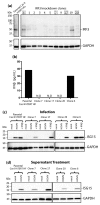Interferon-Independent Upregulation of Interferon-Stimulated Genes during Human Cytomegalovirus Infection is Dependent on IRF3 Expression
- PMID: 30871003
- PMCID: PMC6466086
- DOI: 10.3390/v11030246
Interferon-Independent Upregulation of Interferon-Stimulated Genes during Human Cytomegalovirus Infection is Dependent on IRF3 Expression
Abstract
The antiviral activity of type I interferons (IFNs) is primarily mediated by interferon-stimulated genes (ISGs). Induction of ISG transcription is achieved when type I IFNs bind to their cognate receptor and activate the Janus Kinase/Signal Transducer and Activator of Transcription (JAK/STAT) signaling pathways. Recently it has become clear that a number of viruses are capable of directly upregulating a subset of ISGs in the absence of type I IFN production. Using cells engineered to block either the response to, or production of type I IFN, the regulation of IFN-independent ISGs was examined in the context of human cytomegalovirus (HCMV) infection. Several ISGs, including IFIT1, IFIT2, IFIT3, Mx1, Mx2, CXCL10 and ISG15 were found to be upregulated transcriptionally following HCMV infection independently of type I IFN-initiated JAK-STAT signaling, but dependent on intact IRF3 signaling. ISG15 protein regulation mirrored that of its transcript with IFNβ neutralization failing to completely inhibit ISG15 expression post HCMV infection. In addition, no detectable ISG15 protein expression was observed following HCMV infection in IRF3 knockdown CRISPR/Cas-9 clones indicating that IFN-independent control of ISG expression during HCMV infection of human fibroblasts is absolutely dependent on IRF3 expression.
Keywords: IRF3; ISG15; human cytomegalovirus; interferon; interferon stimulated genes.
Conflict of interest statement
The authors declare no conflict of interest.
Figures



Similar articles
-
Interferon-Independent Innate Responses to Cytomegalovirus.Front Immunol. 2019 Dec 11;10:2751. doi: 10.3389/fimmu.2019.02751. eCollection 2019. Front Immunol. 2019. PMID: 31921100 Free PMC article. Review.
-
UL26 Attenuates IKKβ-Mediated Induction of Interferon-Stimulated Gene (ISG) Expression and Enhanced Protein ISGylation during Human Cytomegalovirus Infection.J Virol. 2019 Nov 13;93(23):e01052-19. doi: 10.1128/JVI.01052-19. Print 2019 Dec 1. J Virol. 2019. PMID: 31534044 Free PMC article.
-
RIG-I is a key antiviral interferon-stimulated gene against hepatitis E virus regardless of interferon production.Hepatology. 2017 Jun;65(6):1823-1839. doi: 10.1002/hep.29105. Epub 2017 May 3. Hepatology. 2017. PMID: 28195391
-
Human IFIT3 Protein Induces Interferon Signaling and Inhibits Adenovirus Immediate Early Gene Expression.mBio. 2021 Dec 21;12(6):e0282921. doi: 10.1128/mBio.02829-21. Epub 2021 Nov 2. mBio. 2021. PMID: 34724821 Free PMC article.
-
Interferon-Stimulated Genes as Enhancers of Antiviral Innate Immune Signaling.J Innate Immun. 2018;10(2):85-93. doi: 10.1159/000484258. Epub 2017 Nov 30. J Innate Immun. 2018. PMID: 29186718 Free PMC article. Review.
Cited by
-
Analysis of gene expression in monocytes of immunized pigs after infection with homologous or heterologous African swine fever virus.Front Vet Sci. 2022 Aug 12;9:936978. doi: 10.3389/fvets.2022.936978. eCollection 2022. Front Vet Sci. 2022. PMID: 36032295 Free PMC article.
-
The battle between host antiviral innate immunity and immune evasion by cytomegalovirus.Cell Mol Life Sci. 2024 Aug 9;81(1):341. doi: 10.1007/s00018-024-05369-y. Cell Mol Life Sci. 2024. PMID: 39120730 Free PMC article. Review.
-
Astrocyte Control of Zika Infection Is Independent of Interferon Type I and Type III Expression.Biology (Basel). 2022 Jan 15;11(1):143. doi: 10.3390/biology11010143. Biology (Basel). 2022. PMID: 35053142 Free PMC article.
-
Involvement of RIG-I Pathway in Neurotropic Virus-Induced Acute Flaccid Paralysis and Subsequent Spinal Motor Neuron Death.mBio. 2021 Dec 21;12(6):e0271221. doi: 10.1128/mBio.02712-21. Epub 2021 Nov 16. mBio. 2021. PMID: 34781742 Free PMC article.
-
Classical swine fever virus Npro antagonises IRF3 to prevent IFN-independent TLR3 and RIG-I-mediated apoptosis.J Virol. 2020 May 1;95(9):e01136-20. doi: 10.1128/JVI.01136-20. Epub 2020 Dec 16. J Virol. 2020. PMID: 33328306 Free PMC article.
References
-
- Mujtaba G., Shaukat S., Angez M., Alam M.M., Hasan F., Zahoor Zaidi S.S., Shah A.A. Seroprevalence of Human Cytomegalovirus (HCMV) infection in pregnant women and outcomes of pregnancies with active infection. JPMA J. Pak. Med. Assoc. 2016;66:1009–1014. - PubMed
Publication types
MeSH terms
Substances
LinkOut - more resources
Full Text Sources
Research Materials
Miscellaneous

